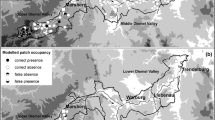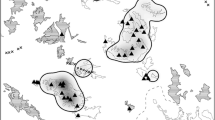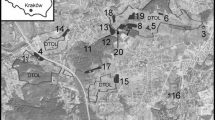Abstract
While there is agreement that both habitat quality and habitat network characteristics (such as patch size and isolation) contribute to the occupancy of patches by any given species, the relative importance of these factors is under debate. This issue is of fundamental ecological importance, and moreover of special concern for conservation biologists aiming at preserving endangered species. Against this background we investigated patch occupancy in the violet copper Lycaena helle, one of the rarest butterfly species in Central Europe, in the Westerwald area (Rhineland-Palatinate, Western Germany). Occupied (n = 102) differed from vacant (n = 128) patches in altitude, size, connectivity, availability of wind shelter, in the abundance of the larval host-plant, in the abundance of a grass species indicating favorable habitat conditions and in the abundance of nitrophilous plants. Overall, patch occupancy was primarily determined by patch size, connectivity and the abundance of the larval host plant, while all other parameters of habitat quality were of subordinate importance. Therefore, our findings suggest that even for extremely sedentary species such as L. helle habitat networks are decisive and—next to the preservation of habitat quality—need to be an integral part of any conservation management for this species.

Similar content being viewed by others
References
Anthes N, Fartmann T, Hermann G, Kaule G (2003) Combining larval habitat quality and metapopulation structure – the key for successful management of pre-alpine Euphydryas aurinia colonies. J Insect Conserv 7:175–185
Armstrong DP (2005) Integrating the metapopulation and habitat paradigms for understanding broad-scale declines of species. Conserv Biol 19:1402–1410
Baguette M (2003) Long distance dispersal and landscape occupancy in a metapopulation of the cranberry fritillary butterfly. Ecography 26:153–160
Bender DJ, Contreras TA, Fahrig L (1998) Habitat loss and population decline: a meta-analysis of the patch size effect. Ecology 79:517–533
Betzholtz P-E, Ehrig A, Lindeborg M, Dinnétz P (2007) Food plant density, patch isolation and vegetation height determine occurrence in a Swedish metapopulation of the marsh fritillary Euphydryas aurinia (Rottemburg, 1775) (Lepidoptera, Nymphalidae). J Insect Conserv 11:343–350
Binzenhöfer B, Schröder B, Strauss B, Biedermann R, Settele J (2005) Habitat models and habitat connectivity analysis for butterflies and burnet moths—the example of Zygaena carniolica and Coenonympha arcania. Biol Conserv 126:247–259
Binzenhöfer B, Biedermann R, Settele J, Schroeder B (2008) Connectivity compensates for low habitat quality and small patch size in the butterfly Cupido minimus. Ecol Res 23:259–269
Bourn NAD, Thomas JA (1993) The ecology and conservation of the brown argus butterfly Aricia agestis in Britain. Biol Conserv 63:67–74
Dennis RLH, Eales HT (1997) Patch occupancy in Coenonympha tullia (Müller, 1764) (Lepidoptera: Satyrinae): habitat quality matters as much as patch size and isolation. J Insect Conserv 1:167–176
Dennis RLH, Eales HT (1999) Probability of site occupancy in the large heath butterfly Coenonympha tullia determined from geographical and ecological data. Biol Conserv 87:295–301
Dennis RLH, Hardy PB (2007) Support for mending the matrix: resource seeking by butterflies in apparent non-resource zones. J Insect Conserv 11:157–168
Dennis RLH, Shreeve TG (1996) Butterflies on British and Irish Offshore Islands. Gem Publishing Company, Oxford
Dennis RLH, Sparks TH (2006) When is a habitat not a habitat? Dramatic resource use changes under differing weather conditions for the butterfly Plebejus argus. Biol Conserv 129:291–301
Dennis RLH, Shreeve TG, van Dyck H (2006) Habitats and resources: the need for a resource-based definition to conserve butterflies. Biodivers Conserv 15:1943–1966
Dover JW, Sparks TH, Greatorex-Davies JN (1997) The importance of shelter for butterflies in open landscapes. J Insect Conserv 1:89–97
Ebert G, Rennwald E (1993) Die Schmetterlinge Baden-Württembergs, Tagfalter. Ulmer Verlag, Stuttgart
Elligsen H, Beinlich B, Plachter H (1997) Effects of large scale grazing on populations of Coenonympha glycerion and Lasiommata megera (Lepidoptera: Satyridae). J Insect Conserv 1:13–23
Fischer K, Beinlich B, Plachter H (1999) Population structure, mobility and habitat preferences of the violet copper Lycaena helle (Lepidoptera: Lycaenidae) in Western Germany: implications for conservation. J Insect Cons 3:43–52
Hanski I (1994) Patch-occupancy dynamics in fragmented landscapes. Trends Ecol Evol 9:131–135
Hanski I (1998) Metapopulation ecology. Oxford University Press, Oxford
Hanski I (2001) Spatially realistic theory of metapopulation ecology. Naturwissenschaften 88:372–381
Hanski I, Pakkala T, Kuussaari M, Lei G (1995) Metapopulation persistence of an endangered butterfly in a fragmented landscape. Oikos 72:21–28
Haynes KJ, Dillemuth FP, Anderson BJ, Hakes AS, Jackson HB, Jackson SE, Cronin JT (2007) Landscape context outweighs local habitat quality in its effects on herbivore dispersal and distribution. Oecologia 151:431–441
Hill JK, Thomas CD, Lewis OT (1996) Effects of habitat patch size and isolation on dispersal by Hesperia comma butterflies: implications for metapopulation structure. J Anim Ecol 65:725–735
Krauss J, Steffan-Dewenter I, Tscharntke T (2003) Local species immigration, extinction, and turnover of butterflies in relation to habitat area and habitat isolation. Oecologia 137:591–602
Krauss J, Steffan-Dewenter I, Tscharntke T (2004) Landscape occupancy and local population size depends on host plant distribution in the butterfly Cupido minimus. Biol Conserv 120:355–361
Maes D, Shreeve TG, Dennis RLH (2006) A special issue on insect habitats. J Insect Conserv 10:1089–1093
Moilanen A, Nieminen M (2002) Simple connectivity measures in spatial ecology. Ecology 83:1131–1145
New TR (2007) Understanding the requirements of the insects we seek to conserve. J Insect Conserv 11:95–97
Nowicki P, Pepkowska A, Kudlek J, Skórka P, Witek M, Settele J, Woyciechowski M (2007) From metapopulation theory to conservation recommendations: lessons from spatial occurrence and abundance patterns of Maculinea butterflies. Biol Conserv 140:119–129
Ockinger E (2006) Possible metapopulation structure of the threatened butterfly Pyrgus armoricanus in Sweden. J Insect Conserv 10:43–51
Sabel K-J, Fischer E (1992) Boden- und vegetationsgeographische Untersuchungen im Westerwald. Frankfurter geowiss. Arbeiten D 7:1–268
Sawchik J, Dufrêne M, Lebrun P (2003) Estimation of habitat quality based on plant community, and effects of isolation in a network of butterfly habitat patches. Acta Oecologia 24:25–33
Schultz CB, Crone EE (2004) Patch size and connectivity thresholds for butterfly habitat restoration. Conserv Biol 19:887–896
Scion Corporation (2000) Scion Image, Release Beta 4.02. Maryland, USA
Smallidge PJ, Leopold DJ (1997) Vegetation management for the maintenance and conservation of butterfly habitats in temperate human-dominated landscapes. Landscape Urban Plan 38:259–280
StatSoft Inc. (2003) Statistica for Windows. Version 6.1. Tulsa, USA
Thomas CD, Thomas JA, Warren MS (1992) Distributions of occupied and vacant butterfly habitats in fragmented landscapes. Oecologia 92:563–567
Thomas JA, Bourn NAD, Clarke RT, Stewart RT, Simcox DJ, Pearman GS, Curtis R, Goodger B (2001) The quality and isolation of habitat patches both determine where butterflies persist in fragmented landscapes. Proc R Soc Lond B 268:1791–1796
Van Swaay CAM, Warren MS (1999) Red Data Book of European Butterflies (Rhopalocera), Nature and Environment No. 99, Council of Europe Publishing, Strasbourg
Vandewoestijne S, Martin T, Liégeois S, Baguette M (2004) Dispersal, landscape occupancy and population structure in the butterfly Melanargia galathea. Basic Appl Ecol 5:581–591
Weidemann HJ (1995) Tagfalter beobachten, bestimmen. Naturbuch, Augsburg
Wenzel M, Schmitt T, Weitzel M, Seitz A (2006) The severe decline of butterflies on western German calcerous grasslands during the last 30 years: a conservation problem. Biol Conserv 128:542–552
Wynne IR, Loxdale HD, Brookes CP, Woiwood IP (2003) Genetic structure of fragmented November moth (Lepidoptera: Geometridae) populations in farmland. Biol J Linn Soc 78:467–477
Acknowledgments
We thank the Ministry of Environment and Forestry of Rhineland-Palatinate/Germany for financial support (fellowship to AD). SSB and KF were funded by the German Research Council during this study (DFG grant no. Fi 846/1-2, 846/1-3, and 846/1-4 to KF).
Author information
Authors and Affiliations
Corresponding author
Rights and permissions
About this article
Cite this article
Bauerfeind, S.S., Theisen, A. & Fischer, K. Patch occupancy in the endangered butterfly Lycaena helle in a fragmented landscape: effects of habitat quality, patch size and isolation. J Insect Conserv 13, 271–277 (2009). https://doi.org/10.1007/s10841-008-9166-1
Received:
Accepted:
Published:
Issue Date:
DOI: https://doi.org/10.1007/s10841-008-9166-1




